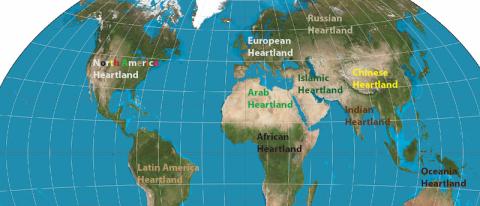Apportioned (distributed) Heartland
Primary tabs

The classical schools of geopolitics recognize a deep dualism between the Civilization of Land (Heartland) and the Civilization of Sea. As Mackinder said, he who controls Eastern Europe, controls Heartland, and he who controls Heartland, controls the world. This idea was subsequently developed by Spykman into “He who controls Rimland (the coastal zone), controls Heartland.’
The fight to rule Heartland - by Sea Power from without, or in the Heartland itself from within - is the main formula of geopolitical history. Geopolitics is the battle for Heartland.
In the bipolar world, Heartland was represented by the Eastern camp, first and foremost the USSR, while Sea Power was the Western camp (Western Europe, the countries loyal to the West in the Middle East, etc.). Heartland, in the face of the USSR, lost this war in the late 1980’s, which marked the beginning of the unipolar moment. Fukuyama thus proclaimed the End of History; he declared that Sea Power had beaten Heartland.
Today we speak about the multipolar world and how Russia, despite its terrible losses, has preserved its identity, come to its senses, and has ever so slightly squeezed the Fifth Column. The unipolar domination of Sea Power has somewhat retreated. But at any rate, it is evident that Fukuyama prematurely declared the End of History and the global victory of liberalism.
But here arises a contradiction. If we take into consideration only one Sea Power and one Heartland, and yet if we speak of a multipolar world, then Russia cannot be the only Heartland. In the very least, it is one of four or five of the most important poles. Russia should be the center or one of the poles of the new world.
It is high time to introduce the notion of an apportioned (distributed) Heartland. We should attentively examine German geopolitics of the 1920-’30’s, which proclaimed Germany to be the European Heartland. Of interest to us is not so much Germany itself as the possibility of considering an additional Heartland.
There is the Russian, Eurasian Heartland, but it cannot assert itself as Land Power alone. As follows, it is necessary to look attentively into a European Heartland: for example, a Franco-Germanic alliance (Paris-Berlin-Moscow). Continental Europe can be seen as one Heartland which should be friendly towards the Russian Heartland while being an independent phenomenon.
A Chinese Heartland is an altogether different question. If we recognize China as bearing the status of a Heartland, then we are emphasizing the conservative aspect of China - China as Land Power. But if China declares itself to be a Heartland against Russia, just as Hitler’s Germany declared itself to be Eurasia against Russia, then conflict will immediately arise. But in the case of an apportioned (distributed) Heartland, this acquires a completely different meaning.
Then it is possible to consider such Heartlands as a Russian Heartland, a European Heartland, a Chinese Heartland, and an Islamic Heartland (at least 3-4 empires from Turkey to Pakistan). The concept of an apportioned Heartland can be expanded to India, and projected onto Latin America and Africa as well.
As follows, there should be an American Heartland in the multipolar system, which should not be seen as in opposition to other Heartlands. If we take Heartland to be an apportioned type of culture associated with the reinforcement of conservative identity, then the thesis “Make America Great Again” is that of an American Heartland. Stop being a Sea Power, and you will be Great Again.
An apportioned (distributed) Heartland is the imperative of the new geopolitical model, of multipolar geopolitics.
translated dy Jaf Arnoldsky
